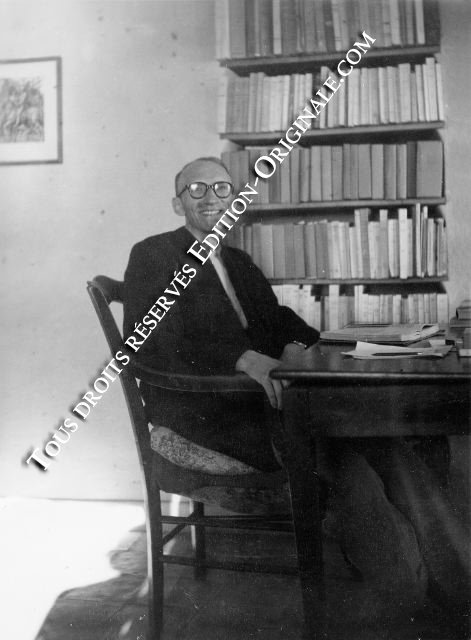Details
Keyword
Œuvres d'art|Photographies
Binding description
une feuille
Description
Elbeuf S.d (Circa 1900) | 10.50 x 16.50 cm | une feuille | Original photograph of Maurice Blanchot seated at his desk, before his library Original photograph of Maurice Blanchot, smiling, at his desk before his library. Contemporary silver print. “Blanchot eluded the photographers and caricaturists of the literary press for a long time. Attempts at producing an image were both rare and minimalist throughout the years. In 1962, in Express, a hand holds up a book at the bottom of the page; in 1979, in Libération, a blank square in the middle of the page captioned only with Blanchot’s name and a quotation from l’Entretien infini ("a vacuum of a universe: nothing that is visible, nothing that is invisible”)” (C. Bident, Maurice Blanchot). In 1986, at an exhibition of writers’ portraits, he asked that his photo be replaced with a text noting his desire to “appear as little as possible, not for the exaltation of [his] books, but to avoid the presence of an author who pretends to a separate existence.” A photo taken without his knowledge in the parking lot of a supermarket was the only portrait of the writer until his friend Emmanuel Lévinas made public a few rare photos from their youth. That Blanchot did not oppose this act, and the fact that it was done by his closest friend, can be explained by what Bident calls “l'espacement de l'inquiétude [the distancing of worry]”, the outdated nature of the portraits made public carry an echo of the delayed publication of L'Idylle, Le Dernier Mot, L'Arrêt de mort.). Only a few photographs gathered in the centre pages of the issue of les Cahiers de l'Herne dedicated Maurice Blanchot complement these unique shots of the most secretive writer of the 20 th century. In his chapter on “L'indisposition du secret [The indisposition of the secret]”, Christophe Bident devotes several pages to the almost complete absence of images of this invisible partner, wondering about the intellectual and psychological motivations of the writer, who was nonetheless aware of the inevitable revelation to come. “Everything must become public. The secret must be broken. The obscure must enter into the day and make itself clear. That which cannot be said must nonetheless make itself heard. Quidquid latet apparebit, everything that is hidden must appear…” Maurice Blanchot, L'Espace littéraire). * [FRENCH VERSION FOLLOWS] | Photographie originale de Maurice Blanchot, souriant, assis à sa table de travail devant la bibliothèque. Tirage argentique d'époque. « Blanchot mit longtemps au défi photographes et caricaturistes de la presse littéraire. Minimalistes et rarissimes, sur tant d'années, sont les esquisses d'illustrations : en 1962 dans l'Express, une main brandit un livre, sur fond de page ; en 1979, dans Libération, un carré vierge au milieu de la page, portant pour toute légende le nom de Maurice Blanchot et une citation de l'Entretien infini ("un vide d'univers: rien qui fut visible, rien qui fut invisible") » (C. Bident, Maurice Blanchot). En 1986, à l'occasion d'une exposition de portraits d'écrivains, il demande que sa photo soit remplacée par un texte manifestant son désir d'« apparaître le moins possible, non pas pour exalter [ses] livres, mais pour éviter la présence d'un auteur qui prétendrait à une existence propre » . Une photo prise à son insu par un paparazzo sur un parking de supermarché, fera longtemps office de portrait de l'écrivain avant que son ami Emmanuel Lévinas ne dévoile quelques rares portraits de leur jeunesse. Que Maurice Blanchot ne se soit pas opposé à cette divulgation, que celle-ci soit le fait de son plus proche ami, pourrait s'expliquer par ce que Bident nomme « l'espacement de l'inquiétude », l'inactualité des portraits dévoilés faisant écho aux publications reportées de L'Idylle, Le Dernier Mot, L'Arrêt de mort.). Seules quelques photographies rassemblées dans les pages centrales du numéro des Cahiers de l'Herne consacré à Maurice Blanchot complètent ces clichés u

Find out how to use
Find out how to use

